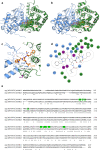This is a preprint.
Expanding the ligandable proteome by paralog hopping with covalent probes
- PMID: 38293178
- PMCID: PMC10827202
- DOI: 10.1101/2024.01.18.576274
Expanding the ligandable proteome by paralog hopping with covalent probes
Abstract
More than half of the ~20,000 protein-encoding human genes have at least one paralog. Chemical proteomics has uncovered many electrophile-sensitive cysteines that are exclusive to a subset of paralogous proteins. Here, we explore whether such covalent compound-cysteine interactions can be used to discover ligandable pockets in paralogs that lack the cysteine. Leveraging the covalent ligandability of C109 in the cyclin CCNE2, we mutated the corresponding residue in paralog CCNE1 to cysteine (N112C) and found through activity-based protein profiling (ABPP) that this mutant reacts stereoselectively and site-specifically with tryptoline acrylamides. We then converted the tryptoline acrylamide-N112C-CCNE1 interaction into a NanoBRET-ABPP assay capable of identifying compounds that reversibly inhibit both N112C- and WT-CCNE1:CDK2 complexes. X-ray crystallography revealed a cryptic allosteric pocket at the CCNE1:CDK2 interface adjacent to N112 that binds the reversible inhibitors. Our findings thus provide a roadmap for leveraging electrophile-cysteine interactions to extend the ligandability of the proteome beyond covalent chemistry.
Figures
















Similar articles
-
An allosteric cyclin E-CDK2 site mapped by paralog hopping with covalent probes.Nat Chem Biol. 2025 Mar;21(3):420-431. doi: 10.1038/s41589-024-01738-7. Epub 2024 Sep 18. Nat Chem Biol. 2025. PMID: 39294320 Free PMC article.
-
Multi-tiered chemical proteomic maps of tryptoline acrylamide-protein interactions in cancer cells.Nat Chem. 2024 Oct;16(10):1592-1604. doi: 10.1038/s41557-024-01601-1. Epub 2024 Aug 13. Nat Chem. 2024. PMID: 39138346 Free PMC article.
-
Assigning functionality to cysteines by base editing of cancer dependency genes.Nat Chem Biol. 2023 Nov;19(11):1320-1330. doi: 10.1038/s41589-023-01428-w. Epub 2023 Oct 2. Nat Chem Biol. 2023. PMID: 37783940 Free PMC article.
-
[Advances in applications of activity-based chemical probes in the characterization of amino acid reactivities].Se Pu. 2023 Jan;41(1):14-23. doi: 10.3724/SP.J.1123.2022.05013. Se Pu. 2023. PMID: 36633073 Free PMC article. Review. Chinese.
-
Reimagining Druggability Using Chemoproteomic Platforms.Acc Chem Res. 2021 Apr 6;54(7):1801-1813. doi: 10.1021/acs.accounts.1c00065. Epub 2021 Mar 18. Acc Chem Res. 2021. PMID: 33733731 Review.
References
-
- Ibn-Salem J. et al. Co-regulation of paralog genes in the three-dimensional chromatin architecture. Nucleic Acids Res 45, 81–91 (2017). https://doi.org:10.1093/nar/gkw813 - DOI - PMC - PubMed
-
- Man O. et al. From subgenome analysis to protein structure. Curr Opin Struct Biol 13, 353–358 (2003). https://doi.org:10.1016/s0959-440x(03)00071-x - DOI - PubMed
-
- Conant G. C. et al. Turning a hobby into a job: how duplicated genes find new functions. Nat Rev Genet 9, 938–950 (2008). http://doi.org:10.1038/nrg2482 - DOI - PubMed
-
- Ryan C. J. et al. Targeting synthetic lethal paralogs in cancer. Trends Cancer 9, 397–409 (2023). https://doi.org:10.1016/j.trecan.2023.02.002 - DOI - PubMed
-
- Xin Y. et al. Paralog-based synthetic lethality: rationales and applications. Front Oncol 13, 1168143 (2023). https://doi.org:10.3389/fonc.2023.1168143 - DOI - PMC - PubMed
Publication types
Grants and funding
LinkOut - more resources
Full Text Sources
Molecular Biology Databases
